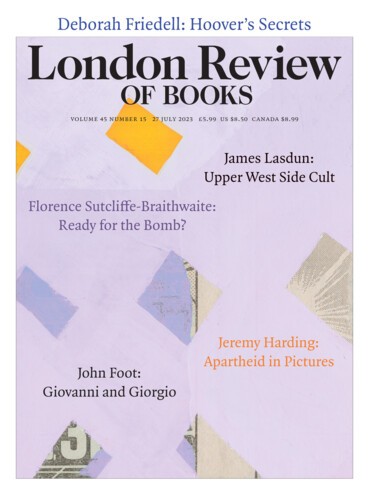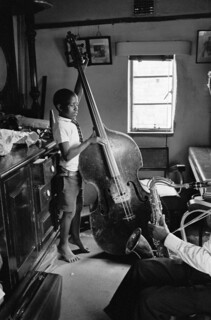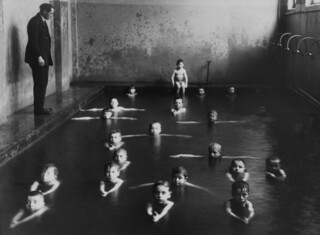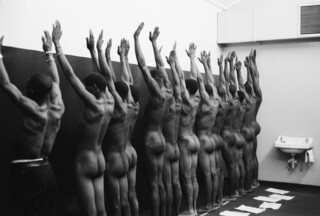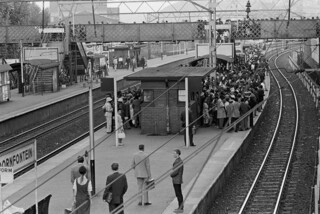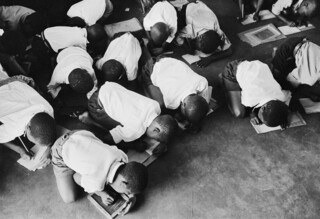Photography in the industrial age was fascinated by the subject of work. The readying of humans for their roles in the workforce was a minor subgenre of this huge documentary field. A glimpse of labour in the making was provided in the 1930s by the photographer François Kollar, shooting in a desolate concrete chamber where young French children were learning to swim. An instructor in a suit looks on from the edge of the pool. Pale white arms push forward through the dark water or extend like luminous floats either side of bobbing heads. Flooding in the pits was one of the risks these children would face when they followed their elders into France’s mines, working the coalfields of the north-east.
In the 1960s, the Black South African photographer Ernest Cole (b. 1940) recorded a medical examination of adult males in the gold mines on the Witwatersrand. In Cole’s picture a dozen naked men stand with their faces to the wall, arms raised. Unlike the children in Kollar’s picture, Cole’s adults are doubly vulnerable, as labouring poor and racialised inferiors. Cole’s politics were opaque, he didn’t give much away, but his photographs suggest that he saw racism as a more decisive force in South Africa than the structural injustices of capitalism, even though the ANC – which read racism back onto class struggle – used his work to publicise their cause. White employees in the mines, he noted, ‘even those working underground, and designated as miners, never touch pick or shovel or drilling machines. The brute work is done by Africans.’ His photos of mining recruits came to international attention in House of Bondage, a study of life – and lives – in apartheid South Africa, published in the US in 1967 and subtitled ‘A South African Black man exposes in his own pictures and words the bitter life of his homeland today.’ An impressive new edition includes an additional sequence of photographs and a set of critical essays on Cole’s work.
Ernest Levi Tsoloane Kole was born in a Black township on the edge of Pretoria to a tailor and a laundress; he was one of six siblings. Intrigued by photography as a child, he became hooked in his teens. The Bantu Education Act of 1953 did for the prospects of most Black pupils in the apartheid system. Cole was thirteen. Hendrik Verwoerd, minister of Native Affairs at the time, argued that there was no point teaching maths to a ‘Bantu child … when it cannot use it in practice.’ In his late teens Cole began a correspondence course with Wolsey Hall in Oxford, and another, not long after, with the New York Institute of Photography. He also gained work at Zonk!, a mass-circulation magazine founded in 1949 and aimed at a Black South African readership with money to spend. Not much is known about how Cole got on at Zonk! or what he did. The magazine carried stories about music, South African sport and beauty contests; it ran serialised fiction, noirish or spooky, and mild-mannered debates on issues of the day. Zonk!’s star photographer was Mabel Cetu, one of the few contributors to earn photo credits and now an object of great scholarly interest. Advertising was plentiful: for women readers, powdered milk, margarine, skin whiteners and deodorants (Odo-ro-no, ‘a good idea for men too’); wide-brimmed hats and bicycles for men. But selling a race-specific template to Black people was a challenge in a country whose laws were eating away the disposable income of its consumer base and Zonk! survived for only a few more years.
In 1958 Cole moved to Drum, an outspoken monthly of fiction, art, photography and gutsy reportage on the effects of apartheid. It ran music reviews, sports news, grapevine gossip, tales of misdemeanour and street life. The deeds of petty township criminals (tsotsis) with flamboyant dress styles and nimble fingers were a regular theme. When Cole was taken on as a junior assistant (darkroom duties and layout), the magazine’s great days under Anthony Sampson and Sylvester Stein – and the energetic assistant editor Henry Nxumalo, who was murdered on an investigative assignment – were coming to an end. Stein’s successor, Tom Hopkinson, was a more cautious editor, but Drum had assembled some of the best writers in the country, among them Es’kia Mphahlele, Lewis Nkosi and Bessie Head, as well as gifted photographers, and there was no shortage of energy.
In the early 1950s the Drum crew had hung out in Sophiatown, a suburb north-west of Johannesburg inhabited mostly by low-income Black freeholders and their live-in tenants, roughly 55,000 in all; the rest – a few thousand – were Coloured, Indian and Chinese. Sophiatown was a patchwork of modest wealth and downward mobility; it was also the setting for something akin to the Harlem Renaissance in New York during the 1920s. White intellectuals and dissidents shuttled back and forth, mixing with novelists, dramatists, poets and artists who had turned the neighbourhood into a hub of culture and politics. But Cole arrived on the scene too late to catch the flavour of the place: in 1955 two thousand armed police were deployed to evict the residents (most were relocated to Soweto) and the long process of demolition began. Sophiatown was renamed Triomf.
Cole was young, apparently unassuming, profoundly ambitious. On one occasion at Drum he seized on the chance to stand in for an absentee on a photoshoot for a Chamber of Mines advertising spread (the magazine ticked over on mining revenues). The mineworkers on the Reef made a lasting impression on him. After Drum, he did a stint at the daily Bantu World and returned to the mining compounds to gather material for House of Bondage. ‘To the white guards,’ he recalled, ‘I was just another kaffir and they paid no attention to me … I had considerable freedom to see what I wanted to see.’ By then he had learned to insinuate his way into the white man’s domain unannounced, shoot a reel of film and fade away like a wraith. This was the modus operandi that enabled many scenes in House of Bondage.
The results of Cole’s ice-cool forays into dangerous territory often look poised and considered, as if he’d been assigned to shoot a commercial or a sports day prizegiving. It’s said that he used a Yashica-C with a waist-level viewfinder. That would make sense of the suggestion that he hid his camera in a sandwich bag, having opened a hole for the lenses. Many photographers, amateurs included, liked this waist-level arrangement: bag or no bag, you could take a picture without telegraphing your intentions. (In war-torn Algeria, as Cole was mastering his trade, the young Pierre Bourdieu was taking hundreds of pictures for his research files with a Zeiss Ikoflex, often ‘without anybody noticing’.) But we know, too, that Cole had his hands on a Nikon rangefinder when he shot most of the material for House of Bondage in the mid-1960s: his flatmate Struan Robertson, also a photographer, remembers him practising with the eye-level viewfinder for maximum speed of execution ‘like a handgun expert’. Raise, focus, shoot, conceal.
This kind of discretion isn’t unusual for photojournalists, but Cole’s was existential, a studious absenteeism. He could poke fun at his colleagues or get fiery, arguing furiously over a credit for a disputed photo that had appeared in print, but mostly he was courteous and inscrutable, a virtuoso in the art of anger management in an era when anger ran high. The assault on Sophiatown had left people, including staff at Drum, with a sense of loss that can’t have escaped him. Eersterust, a suburb of Pretoria where his parents were freeholders, had been designated a ‘Coloured’ area before they were kicked out in 1960 and their house was razed. ‘Our neighbourhood was rubble,’ he wrote in House of Bondage. ‘Our house was a pile of bricks.’ In the same year the Pan-Africanist Congress stole a march on their rivals, the ANC, and took to the streets of Sharpeville to demonstrate against the hated passbook – an internal travel document that restricted freedom of movement for Black South Africans. Police opened fire on the protesters, leaving 69 dead and 189 injured. In his essay for this new edition, James Sanders suggests that the fate of Eersterust ‘would have taught [Cole] that the struggle with apartheid can never be a fair contest. To resist one had to learn to cheat.’ The Sharpeville massacre, which took place on Cole’s twentieth birthday, may well have been another lesson in the same vein.
Cole went on to play the race hierarchies in South Africa for all he was worth. He changed his name from Kole and persuaded the apartheid authorities to reclassify him as a Coloured person, allowing him to move more freely in white and Coloured areas without a pass. His reassignation was a rare feat and something of a mystery. Perhaps he persuaded the authorities that he had once lived in a Coloured area and that de facto he was a Coloured person. Or that he was an orphan of Coloured parentage. Or perhaps he was pressured to trade information about ANC activists in return for his new status: a bargain he never appears to have kept. Quite when apartheid security first took an interest in Cole is hard to say. In his memoir, In the Fiery Continent (1962), Tom Hopkinson recalled that someone in the Drum darkroom had been approached to work as an informer, though he doesn’t mention Cole by name. It’s possible that Cole’s views as a teenager inclined him to the PAC, which envisaged race struggle – ‘one settler, one bullet’ – as the path to change in South Africa. If he crossed the white/Black divide in his dealings with editors and mentors – or importunate apartheid spooks – it wasn’t to make common cause with white people. Then again, there’s no evidence that he lost sleep about his advantage as a Coloured journalist over his fellow Black photographers, whose careers were hobbled by the pass. The profession was light on camaraderie.
In the early 1960s, Cole was selling pictures to the Johannesburg Sunday Express, the Rand Daily Mail and New Age, a left-wing paper set up in the 1950s when its predecessor the Guardian was banned. He had become a devotee of Henri Cartier-Bresson. Poring over editions of The Decisive Moment (1952) and The People of Moscow (1955), he began to conceive a book of his own that would ‘show the world what the white South African had done to the Black’. But freelancing for New Age left him exposed. Ruth First, a militant in the South African Communist Party and then the ANC, had an influential hand in the paper, and anyone who came within her ambit – including Cole, irrespective of his politics – would have been of interest to the intelligence services. This is another moment when the police could have put the screws on Cole. (New Age was banned; First was detained and left the country after her release; she was assassinated in Maputo in 1982.)
A handful of superb sharp-shooter images in House of Bondage show tsotsis on the move in downtown neighbourhoods: a wallet is lifted in one scene; a man in another scene is mugged. Both victims are white. In one of these incidents, it’s alleged, Cole had befriended a gang and hung around, biding his time for the kill. The police arrived within minutes. Cole was detained and asked to testify in court against the muggers. Whether or not he’d been pressured to inform in the past – at Drum, or during his reclassification hearings, or later as a contributor to New Age – his arrest as a witness to a felony in broad daylight put him in an impossible position. If he refused to testify he would face a spell in detention, where investigations were unlikely to stop at a one-off case against a bunch of petty thieves. The time had come for Cole to pack his bags.
He had struck up an uneasy friendship with Joseph Lelyveld, the New York Times correspondent in Johannesburg. Lelyveld suspected that he was an apartheid informer, a hunch he came to regret. In 1966 Cole, a devout Catholic on the face of it, was waiting for a permit to travel abroad for a pilgrimage to Lourdes. By then Lelyveld had been ordered to leave South Africa. In April, on the day Cole received his travel authorisation, Lelyveld carried a package of Cole’s contact sheets out of the country. Cole left in May and never returned. In his luggage were a handful of layouts and prints. How his negatives followed him into exile is unclear. In one account, he gave some of them to Robertson, who sent them out later. In another, they were left for safekeeping with a staffer at the United States Information Service in Johannesburg. If the USIS connection is true, it marks another strange turn in the winding road to the publication of House of Bondage. USIS was a soft-power, public diplomacy organ at a time when apartheid South Africa was one of Washington’s staunch Cold War partners. With the US enacting civil rights legislation at home and prosecuting a war in Vietnam, the service could well have preferred to cultivate the PAC, whose politics were by a margin more acceptable than the ANC’s Marxist programme. Single-minded and unclubbable, Cole may not have cared either way.
He spent the summer in Europe raising interest in his idea for a devastating photo essay on South Africa. The Sunday Times and Stern were keen, and so was Magnum: Cole’s project was no longer a work in progress but a fully formed achievement in his mind’s eye and he had a dummy of the book to show for it. He arrived in New York in September. At some stage along the way, he was reunited with the negatives for House of Bondage (his USIS benefactor remembers delivering several boxes to the US embassy in Nairobi). The New York offices of Magnum sold a few photos to Life magazine and hired a small press to assemble the book; Random House acquired the package and Lelyveld wrote the introduction. The finished product was a huge success, with foreign rights selling fast and the US edition going rapidly into a second print run. It was banned in South Africa.
House of Bondage is a methodical guide in fifteen chapters to apartheid’s institutions (the pass, the police, education, healthcare), its injustices (grinding poverty, child homelessness, forced removals), its labour arrangements (domestic service, mining, arduous travel to and from the workplace) and the consolations on offer to Black South Africans (crime, religion, alcohol). There is also a dismissive chapter on the African middle class, whom Cole saw as incapable of political leadership ‘because of their emotional alliance with whites’. Each sequence is prefaced with a brilliant exposition – surely the work of several hands, as Cole’s copy went through a demanding editorial process – which sets the scene and then supplies the wider context.
Occasionally Cole tells a story in the first person. ‘My own introduction to hospitals came … when I was involved in a motorbike accident in downtown Johannesburg. The time was a few minutes after noon on a Saturday. Both my legs seemed to be broken and I could do no more than pull myself to the sidewalk and sit there.’ The police arrive quite quickly, but he waits two and a half hours for an ambulance. He spends six days in Baragwanath Hospital, Soweto, waiting for surgery and leaves after 26 days, including a stint in the ‘dumping ward’, where ‘many of the supposed convalescents … were bleeding, some dying. Some were about to be discharged with incompletely healed fractures.’ Cole went back to Baragwanath for his chapter on healthcare. ‘Sometimes I just walked in with my camera concealed. Other times I slipped in after hours, dodging the guards.’ One memorable shot takes the viewer’s eye the length of a ward. Ruched promontories, where bed cradles raise patients’ blankets above their leg injuries, create the impression of a chain of hills. Others show ‘floor patients’ moved outdoors into the sunlight during daytime hours and mobile ‘stretcher cases’ inside the building in a queue for X-rays. (‘Some,’ the brisk marginal note tells us, ‘do not live to end of line.’)
The stillness of the figures in these shots falls short of resignation: Cole portrays them as momentary losers who already have the upper hand in a long waiting game. They keep their counsel; time and demography, it’s implied, are on their side. Like François Kollar’s children training for a mining disaster, Cole’s pupils in his chapter ‘Education for Servitude’ are being primed for a harsh generic destiny, hunched over their exercise books on the floor of a bare classroom. (‘Government,’ his note tells us, ‘is casual about furnishing schools for Blacks.’) His portraits of the immobilised include a banished person, Piet Mokoena, dozing in a remote detention camp in Cape Province with an African-language Bible spread over his face. The hard covers are missing and the uppermost pages are open at Corinthians 2. Banishment, Cole explains, was a way to separate influential dissenters, mostly in rural areas – ‘tribal chiefs, village headmen, or simply men with leadership qualities’ – from their communities ‘in the general public interest’.
Cole took an ecumenical view of religion, arguing that traditional Christianity was losing out to syncretic faiths and Evangelism. Animist cults, meanwhile, had hung onto much of their vitality. Every religious practice, in his chapter on belief systems, finds its likeness in another. In one shot a sick woman in a candlelit room is about to receive the Communion wafer from a priest. The metaphor of Christian sacrament is juxtaposed, in the next, with an ancestor-veneration rite where an initiate drinks blood from the throat of a sacrificial goat ‘to prepare her for possession by an ancestral spirit’. Cole was drawn, like a lot of South African photographers, to the exotic quality of ‘splinter’ churches and indigenous traditions: he didn’t foresee the passionate arguments that would breathe new life into mainstream Christian congregations as eloquent members of the clergy came out against apartheid.
Some of the most striking photos in House of Bondage anticipate the chaotic phase that lay ahead. Cole’s Black commuters scuffling out of focus as they race for trains or clamber over ticket barriers catch the insurrectionary potential of able-bodied people on the move in large numbers, in deliberate contrast to his muted studies in ‘Bantu’ schools, rundown hospitals and dusty banishment camps. Even his shots of tsotsis mugging white men resemble hit-and-run skirmishes in the war against minority rule. An irritable white man lashing out at a child beggar becomes an icon of racist contempt. These shots, and the ones he took through a hole in his legendary lunch bag, help to explain Cole’s interest in Cartier-Bresson’s work, especially Images à la sauvette (ill-gotten images, dodgy business). Its English title, The Decisive Moment, doesn’t really catch what Cole admired about Cartier-Bresson.
House of Bondage opened up a promising future for Cole in the US. On the back of its success, the Ford Foundation put up money for a two-part project about Black lives in America. One element would lift his approach in House of Bondage and apply it to the Southern states, the other would document ghetto communities in the big cities. But Cole failed to come good. Had he foreseen that exile in the US, with its tenuous resemblance to apartheid South Africa, would keep him in the same line of business and then thought better of it? If the experiences of modern African Americans and late-colonial Africans were comparable at all, there was a marked difference by the late 1960s between the effects of structural racism on Black citizens in the US and the legalised immiseration of Cole’s South Africans living under a race dictatorship. Cole may have felt that he couldn’t repurpose House of Bondage as a universal road show of Black suffering. His life unravelled and he began to doubt the purpose of photography. In the 1970s he was shuttling between the US and Sweden, losing his bearings. He went on to become a penniless marginal stranded in New York. On a hospital TV, a week before he died in February 1990, he watched Mandela walk away from Victor Verster prison.
Today Cole is remembered as one of the great witnesses to the apartheid years, thanks in part to an exhibition of his work organised by the Hasselblad Foundation that toured between 2011 and 2014. In 2017 a cache of sixty thousand negatives, deposited by an unknown intermediary, was released to his nephew Leslie Matlaisane by a Swedish bank; some dated from Cole’s days in South Africa, others from his tentative field trips in the US before his Ford Foundation venture bombed. The negatives were shared by Magnum with the Cole family: a few prints are available on the Magnum website. The Hasselblad Foundation has given some of its own holdings to Cole’s descendants but has hung on to more than five hundred vintage prints – an ongoing source of dispute between the Foundation and the family. More of Cole’s work will see the light of day.
A suite of photos that failed to make the cut in earlier editions of House of Bondage appears in the latest under the heading ‘Black Ingenuity’ (Cole’s working title). It concentrates mostly on Dorkay House, an abandoned garment factory in Johannesburg that was turned into a workshop and performance venue after the lease was acquired by the Union of South African Artists in the 1950s. With a big space for dance and theatre, and offices repurposed for music lessons, Dorkay House would come to stand, in noisy, emblematic miniature, for the old buzz of Sophiatown. The musical King Kong, a box office triumph about a Black heavyweight boxer, was rehearsed in the building. Miriam Makeba, Athol Fugard, Abdullah Ibrahim and Hugh Masekela were among the artists who came and went.
Cole must have taken these photos in the 1960s, when the prospects for Black artists were bleak. ‘Remnants,’ he wrote on his draft chapter folder, ‘of culture, creativity, and of all the things they failed to stamp out.’ Even so, he was at home in this anti-apartheid warren and his word ‘ingenuity’ seems to honour the busy African self-reinvention he could still see in the workshops: ingenuity was about making good from making do, trying to keep the show on the road. In one image a young boy in short trousers, short sleeves and tie is poised on tiptoe tuning an antique three-string double bass. By then the big celebrity jazz bassists of the day, Ernest Mothle and Johnny Dyani, were on the path to exile and the international jazz circuit. Talent was seeping out of the country. Makeba, Masekela, Ibrahim and others were gone; Cole’s turn was coming. Beside his little bass player we catch a glimpse of a teacher-accompanist: the sleeve of his shirt, his fingers on the keys of a saxophone. Behind them both is a window onto a brick wall coated with whitewash.
Send Letters To:
The Editor
London Review of Books,
28 Little Russell Street
London, WC1A 2HN
letters@lrb.co.uk
Please include name, address, and a telephone number.
